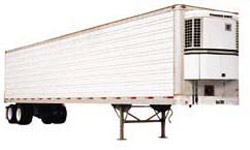 |
 |
Refer Height -- Most have some dimensional differences compared to the dry van trailers that we covered earlier. The most notable difference is the inside height when compared, they are shorter. Most Climate Control trailers vary in height from 100" to 106" of inside height versus the 108" of the dry van. The most common inside height is 104" and it probably represents about 70% of the aggregate capacity of climate control trailers on US highways today. Until very recently have trailer manufacturers begun to produce climate control trailers that are 108" tall inside. Why is that? It has to do with several factors. Probably the most influential is weight. Most states in the US limit by law a combined tractor and trailer gross vehicle weight that is completely loaded (with goods in it) to 80,000 lbs. The effect this has on climate control trailers versus the dry van is climate control trailers historically have weighed more because they have insulted walls and ceilings, and a diesel motor powered air-conditioning unit mounted on the front of the trailer that adds to the weight of the trailer. So, in order to carry a comparable cargo payload without exceeding the weight restrictions, the trade off was less trailer in the form of height. Only recently have improvements in material composites in both insulation and aluminum allowed manufacturers to design larger climate control trailers without sacrificing payload capacity.
|